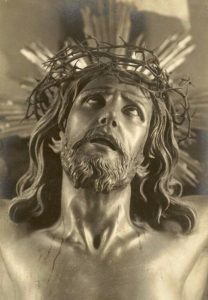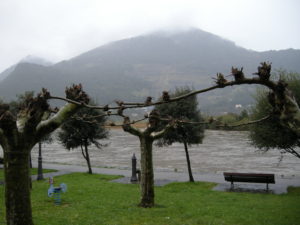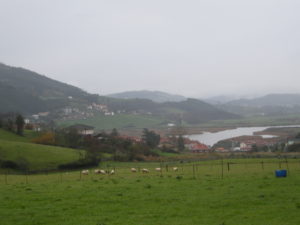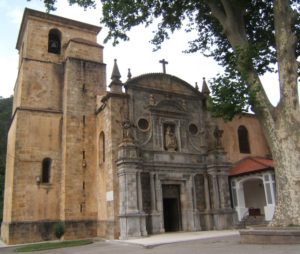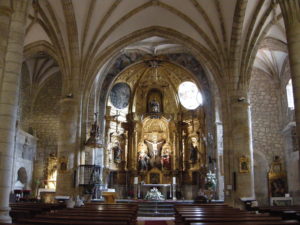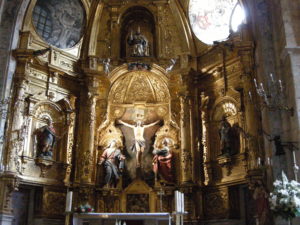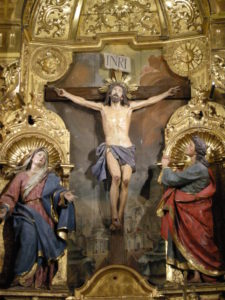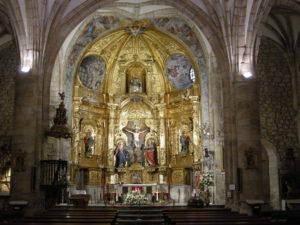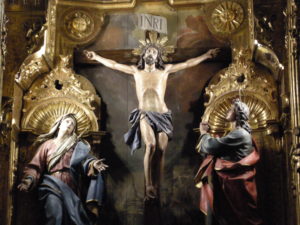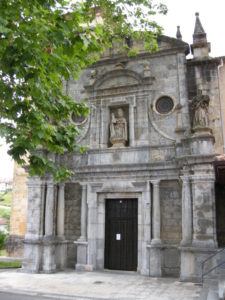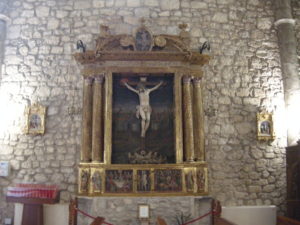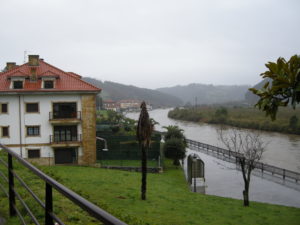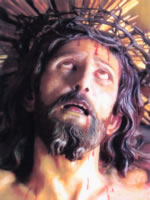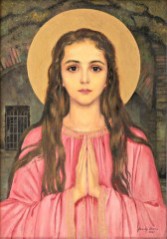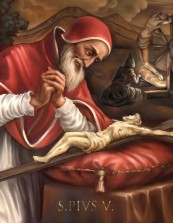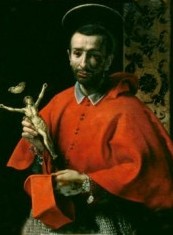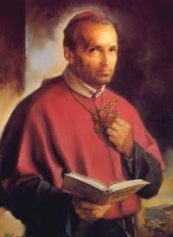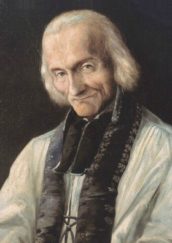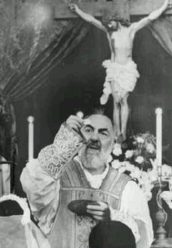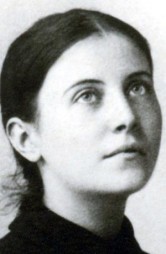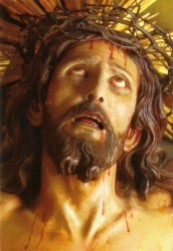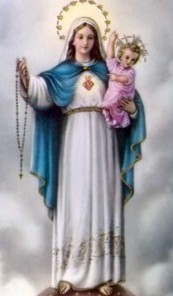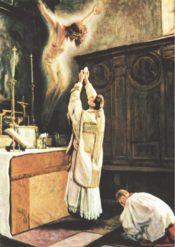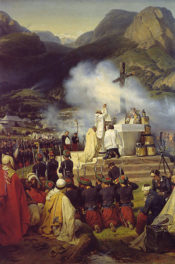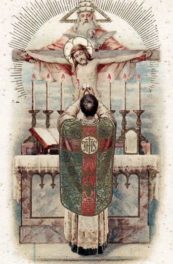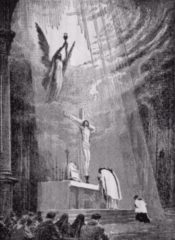Limpias, Spain: Santo Cristo de Limpias
Parish church of St. Peter (Calle Rucoba, Limpias; Tue-Sun 10:30am – 1pm and 4:30pm – 6:15pm, in the summer until 7pm; iglesia de San Pedro Apostol, Limpias)
Limpias is a township (population approx. 1,200) in the northeastern part of the northern Spanish province of Cantabria. It is situated 48 km from Santander (the capital of Cantabria) and 8 km from Laredo.
Limpias can be reached by bus. If you are staying in Santander, there are buses to Laredo, from where another bus can be taken to Limpias. (The schedules of both buses can be seen at alsa.com or alsa.es.) On my visit to Limpias I took the bus to Laredo and then a taxi to Limpias, which was inexpensive and enabled me to spend much more time in Limpias instead of depending on the infrequent Laredo-Limpias bus schedule.
Just above the high altar of Limpias’ 16th century parish church of St. Peter the Apostle is a venerated miraculous crucifix known as Santo Cristo de la Agonia (Christ of the Agony). The statue of Our Lord is in its natural size and the cross has 2.30 meters in height. It represents Him in His last agony on the Cross. Arranged on either side of the crucifix, a little below it, are life-size figures of the Sorrowful Mother and the Apostle John.
The origin of the image is not entirely known but it is thought to be a 17th century work of Pedro de Mena. It was venerated in a Franciscan convent in Cadiz and later in the oratory of a nobleman (Diego de la Piedra y Secadura) who ended up gifting it, in his testament, to his native village of Limpias.
According to tradition, the crucifix had saved Cadiz from a massive tidal wave that was threatening to engulf the city in 1755. The desperate population, facing the destruction of their town, took out in procession the venerated image of Santo Cristo de la Agonia. The waters advancing upon the city suddenly stopped and receded before the holy image. Around the year 1765 the crucifix (along with the statues of Virgin Mary and the Apostle John standing under the Cross) were transferred to the church of St. Peter in Limpias.
The most important events took place from 1919 to 1924 (and to a lesser extent up to 1935). After that period there have been some individual manifestations but nothing comparable to the earlier mass scale occurrences. For many years several volumes of books with the testimonies of those who have seen the miraculous manifestations were preserved in the sacristy of the church of St. Peter.
During the Spanish civil war most of these books were burned, so that only one volume (the third) remains to this day. A few loose pages of records from the years 1922, 1928 and 1935 were saved from the fire and inserted into the earlier (third) volume. Among the witnesses who recorded their testimonies were people from all social classes – simple peasants, doctors, lawyers, churchmen, and members of noble families.
The public knowledge of the miraculous occurrences started on March 30, 1919 when it became widely known that the image of Jesus was moving, opening and closing its eyes, and the body seemed to be alive, suffering, sweating, bleeding. Limpias quickly became a place of pilgrimage, receiving pilgrims (and curiosity-seekers) from all of Europe and even the Americas. The little village in northern Spain became, for some years, Europe’s most popular pilgrimage place, after Rome. (By 1921 Limpias was receiving more visitors than Lourdes.)
However, there were miracles reported several years before the mass scale events. In August of 1914 the Paulist Father Antonio Lopez [the Paulists had a school in Limpias] was installing electrical lighting over the high altar. As he stood on the ladder, his head was right next to that of the image of Santo Cristo. Observing Jesus’ face, he was astonished to see that the eyes were closed. The Father remembered well that the statue’s eyes had always been open. As he was thus starring at the image its eyes suddenly opened. The priest, shocked, lost his balance and fell down from the ladder.
When he told the sacristan of what he just saw, the sacristan didn’t show himself surprised, for he had already heard of similar occurrences related by other people. Fr. Lopez told his religious community what he had witnessed, and his superiors advised him to keep silence about it. He was asked to write a detailed report which was kept private by his Order. Only in March of 1920, one year after the start of the mass occurrences, was this report made public.
In March of 1919 two Capuchin Fathers came to preach a mission in Limpias. After the Mass that concluded the mission one of the Capuchins entered the sacristy to report that something extraordinary was happening with the image of Santo Cristo. Some girls who were close to the altar noticed that the statue of Jesus was opening and closing its eyes. Soon many of the adults, men and women, began exclaiming witnessing the same. When the priests finally managed to get the people to leave the church one of the Capuchins climbed a ladder to inspect the image. He confirmed that the face and neck of Jesus were wet, as if sweating. No such thing was happening with the other two images (of Our Lady and St. John). A further, more thorough, inspection confirmed that the statue did not contain any mechanism that could explain the movements.
The second set of miraculous manifestations took place on Palm Sunday, April 13, 1919. Two prominent men of Limpias, mocking the “hysteria and superstition”, approached the altar, looking upon the crucifix. Suddenly one of them, pointing at the crucifix, fell to his knees. At once the other man also fell to his knees, crying for mercy and proclaiming his belief in the miracle.
The third miracle took place on Easter Sunday, April 20, in the presence of a group of nuns known as the Daughters of the Cross who conducted a girls’ school in Limpias. They saw both the eyes and lips of Christ move. Some of their students also saw the miracle, as did a group of people who were praying the Rosary. The manifestations were repeated almost daily from April 24, 1919.
The notice of the events quickly spread around the province, and soon masses of people started coming to Limpias to witness the miracle. Within six months more than 100,000 people visited the church. The Spanish press reported on the extraordinary happenings, publishing declarations of eyewitnesses.
The parish began to collect written testimonies of visitors who witnessed the events. Between 1919 and 1922 nearly 9,000 witness declarations were recorded. Over 2,500 were sworn under oath. The parish priest, Fr. Eduardo Miqueli, began to publish a monthly bulletin (Echoes of the Cross) that informed of the events and pilgrimages, as well as printing testimonies of the many graces – spiritual as well as corporal – received by the visitors.
Among the countless visitors and pilgrims were many members of Spanish and European nobility. The king of Spain, Alfonso XIII, visited the sanctuary, and the queen did so more than once, as did their children. Many church prelates came to Limpias, either alone or leading pilgrimages; among them cardinals, archbishops and bishops not only from Spain but even as far away as Peru, Mexico and Cuba. Pilgrimages from many European countries were led by their bishops, and in some cases also by high political office holders.
Not all the visitors came in pilgrimage. Many were incredulous, Protestants, and even atheists, who came to disprove the events they mocked and gave no credence to. Many of these also witnessed the miracle, and were forced to acknowledge the facts. Numerous were the conversions among such souls.
The phenomenon was observed from various places in the church, so that it didn’t matter where the person was standing or seated. It could be observed at all times of the day, morning and afternoon. Interestingly, not all those who witnessed these happenings saw the same thing. Thus any sort of optical illusion can safely be ruled out.
As Baron von Kleist, who visited Limpias and wrote a book about the manifestations, reported:
“Many said that the Saviour looked at them; at some in a kindly manner, and at others gravely, and at yet others with a penetrating and stern glance. Many of them saw tears in His eyes; others noticed that drops of blood ran down from the temples pierced by the crown of thorns; some saw froth on His lips and sweat on His body; others again saw how He turned His eyes from side to side, and let His gaze pass over the whole assembly of people; or how, at the Benediction, He made a movement of the eyes as if giving the blessing; how at the same time He moved the thorn-crowned head from one side to the other. Others had the impression that a deep, submissive sigh was wrested from His breast, some believed they saw Him whisper – in short, the most varied manifestations were observed on this crucifix.”
A journalist who witnessed the miracle reported: “I could perceive two movements of the jawbone, as if He were saying two syllables with His lips. I shut my eyes quite tight and asked myself: ‘What will He have said?’ The answer was not long in coming, for in my innermost self I clearly heard the significant and blessed words, ‘Love Me!'”
Among the thousands of written and sworn testimonies were many from priests and religious. A few of these are related below.
In his statement, Father Valentin Incio of Gijon tells that he visited Limpias on August 4, 1919, joining a group of pilgrims. There were 30 to 40 people, two other priests, a woman who was moved to tears, and 10 sailors.
“At first Our Lord seemed to be alive; His head then preserved its customary position and His countenance the natural expression, but His eyes were full of life and looked about in different directions… Then His gaze was directed towards the center, where the sailors stood, whom He contemplated for a long time; then He looked to the left towards the sacristy with a remarkably stern glance which He retained for some time. Now came the most touching moment of all. Jesus looked at all of us, but so gently and kindly, so expressively, so lovingly and divinely, that we fell on our knees and wept and adored Christ… Then Our Lord continued to move His eyelids and eyes, which shone as if they were full of tears; then He moved His lips gently as if He were saying something or praying. At the same time the above mentioned lady who was beside me, saw the Master trying to move His arms and striving to get them loose from the Cross.”
Father Joseph Eisenlohr submitted his statement on June 18, 1921. After offering Holy Mass at the altar below the crucifix, he sat in the church while a Mass was celebrated by another priest. He wrote: “After the Santo Cristo moved His head and eyes for a certain time He began to pull at the shoulders, to writhe and to bend, as a man does when he is nailed alive to a cross. Everything was in motion, only the hands and feet remained nailed fast. In the end the whole body relaxed as if exhausted, then took up its natural position again with the head and eyes turned up in the direction of heaven. This whole scene of the dying Saviour lasted from the Sanctus until after the priest’s Communion…”
A Capuchin, Fr. Antonio Maria de Torrelavega, visited the church of St. Peter on September 11, 1919. He saw blood streaming from the left corner of Our Lord’s mouth. The next day, he “…. observed anew, only still more frequently, the movement of the eyes, and saw, too, once more that blood was flowing down from the corner of the mouth… Several times He also looked at me. Now I felt as if my whole being were shaken violently… I stood up, therefore, and changed places three or four times, always observing, however, the same manifestations… At about two o’clock, as I was kneeling in one of the central benches, I saw the Santo Cristo gazing at me again, and this so affected me that I had to hold on tight to the bench, as my strength was beginning to fail me… I noticed that the countenance changed colour and became bluish and sad. Many other persons who were kneeling round me also observed this… Now I verify it; there is no doubt the Santo Cristo moves His eyes. During my visit I saw the movement of the eyes about fifty times…“
Father Manuel Cubi, an author, lecturer and confessor of the Basilica del Pilar in Zaragoza, gave his statement on December 24, 1919. In the company of a group of people, he saw the Santo Cristo in a death agony. “…One had the impression that Our Lord was trying to loosen Himself from the cross with violent convulsive movements; one thought to hear the death-rattle in His throat. Then He raised His head, turned His eyes, and closed His mouth. Now and then I saw His tongue and teeth… For nearly half an hour He showed us how much we had cost Him, and what He had suffered for us during His abandonment and thirst on the cross.”
There are also many statements from physicians who were at first very skeptical and sought a scientific reason to disprove the “hysteria”. A report made by Dr. Penamaria was published in the paper “La Montana” in May of 1920. The doctor described what seemed to him to be “…a re-enactment of Christ’s death on the Cross.” He writes that after witnessing the movement of the statue’s eyes and mouth, and after changing locations in the church to verify the miracle, he prayed for a more distinctive proof, something more extraordinary, that might dispel his doubts and give him reason to believe the miracle and testify to it.
He then writes: “This request seemed pleasing to Our Lord… A moment later His mouth was twisted sharply to the left, His glassy, pain-filled eyes gazed up to heaven with the sad expression of those eyes that look and yet do not see. His lead colored lips appeared to tremble; the muscles of the neck and breast were contracted and made breathing forced and labored. His features showed the keenest pangs of death. His arms seemed to be trying to get loose from the cross with convulsive backward and forward movements, and showed clearly the piercing agony that the nails caused in His hands at each movement. Then followed the drawing of a breath, then a second… a third… I do not know how many… always with painful oppression; then a frightful spasm, as with someone who is suffocating and struggling for air, at which the mouth and nose were opened wide. Now follows an outpouring of blood, fluid, frothing, that runs over the under-lip, and which the Saviour sucks up with His bluish, quivering tongue, that He slowly and gently passes two or three times in succession over the lower lip; then an instant of slight repose, another slow breath… now the nose becomes pointed, the lips are drawn together rhythmically, and then extend, the bluish cheek-bones project, the chest expands and contracts violently after which His head sinks limply on His breast, so that the back of the head can be seen distinctly. Then… He expires! … I have tried to describe in outline what I saw during more than two hours…”
An atheist medical student, Heriberto de la Villa, gave testimony to his visit from July 8, 1919. Doubting what he was seeing, he changed his location in the church to better study the movements and then saw the crucifix “… gaze upon me with a terrible look full of anger, which makes me shudder, and I cannot help but bow my head… I look up again and see how He is looking to the right, bowing His head, and turns it to the right, so that I can see the crown of thorns from behind… Once again he turns on me the same angry look which makes such a deep impression upon me that I see myself obliged to leave the church.”
Later he returned to the church and saw that,“… little by little the breast and face became dark blue, the eyes move to the right and left, upwards and down, the mouth opens somewhat, as if He were breathing with difficulty. This I saw for fifteen to twenty minutes… I also noticed that above the left eyebrow a wound formed, out of which a drop of blood flowed over the eyebrows, and remained stationary by the eyelids. After that I saw another drop of blood fall from the crown of thorns and flow over the face. I could distinctly discern it, for it was very red and contrasted with the dark blue colour of the face. Then I saw a quantity of blood drip from the crown of thorns onto the shoulder, but without touching the face. He opened His mouth wide, out of which a white matter like froth welled. At this moment a Dominican priest mounted the pulpit, whereupon Christ gazed steadily at him for five or six minutes… When the preacher ended with the words, ‘and now, Santo Cristo, give us Thy blessing’, Christ opened His eyes and mouth, smiling, and bowed His head, as if He wished to give the benediction in reality. At this moment someone who was standing near me asked me if I would venture to swear on oath to what I saw… Then I recognized that Christ wanted to prove to me the truth of what I saw; He opened His mouth again, out of which froth and blood streamed in great quantity and flowed out of the corners of the mouth quite distinctly… Thereafter I believed that it was now my duty to swear upon oath to what I had seen, and I did so in the sacristy of the church.”
Bishop Manuel Ruiz y Rodriguez, of Pinar del Rio, Cuba, was one of several bishops who witnessed the miracles. On his visit to Limpias he received the grace to watch the entire course of Jesus’ Agony on the Cross. Then, returning to his country, in a beautiful pastoral letter, he meditated on the miracles of Christ in the light of the Holy Scriptures and the Church’s teaching. Deeply convinced that the miraculous manifestations come from God, he wrote: “Christ wants to attract people and the world to Himself. Because He wants love, He shows us how He suffers. Because suffering and love are closely related to each other… He died for us. But we despise Him, and the world persecutes Him. He destroys sin and destroys Satan’s rule, and saves the souls that hell’s thief steals from Him. Christ asks for repentance, faith, love, chastity, mortification, humility and meekness. Christ wants us to take up the cross and follow Him. Christ demands repentance.”
It is important to remember that these events began at least five years before, when the Paulist priest Fr. Antonio Lopez saw the statue closing and opening its eyes. Then it was witnessed by the Capuchin missionaries who inspected the image. Therefore, any kind of mass psychosis can be ruled out.
Furthermore, not all the people present in the church at any given moment saw something extraordinary. While some saw Jesus moving, bleeding, and dying on the Cross, others (often sitting right next to them) didn’t see anything out of ordinary. The amount of people in the church had no correlation to how many or how few witnessed the miracle on any given day. Yet even those who never saw anything miraculous returned strengthened in their faith and piety.
Indeed, the religiosity and piety saw a strong increase as a result of the events in Limpias. Innumerable sinners converted and reformed their lives, religious and sacramental life flourished, and a general reform of customs became very notable in the whole region. Thus the miracles associated with Santo Cristo of Limpias brought countless souls to God, to repentance and, we can hope, ultimately to Heaven.
By 1924 the mass scale manifestations had largely stopped. Some records of miraculous occurrences up until 1935 have been preserved but no public record of any events after that date has survived. However, graces of conversion and also physical healing continued to be reported.
There were many miraculous healings associated with the Christ of Limpias. By 1920 doctors certified as inexplicable more than 1,000 such healings. Some of these happened instantly upon a visit to the church of St. Peter, some occurred once the pilgrims returned home, and yet others took place when the sick were touched with an object that had been touched to the miraculous crucifix.
While the Church authorities were observing the happenings in Limpias, and have blessed the pilgrimages, granted indulgences to pilgrims, and praised the wonderful effects on the religious revival, there was never any official pronunciation or Church judgment on the miracles. The bishop of Santander informed the Holy See of the events. However, the Church usually takes many years to issue a judgment on such matters, and since the events in Limpias ceased some years later, it likely wasn’t deemed necessary anymore to proceed with an eventual approval process.
And still, even to this day there are visitors and sometimes small pilgrimages (from all corners of the world), coming to pray, contemplate the beautiful image of the suffering Christ, and remember the events that, a century ago, made the small Spanish village of Limpias world famous.
Adoramus te, Christe, et benedicimus tibi, quia per sanctam crucem tuam redemisti mundum.
—
Santo Cristo de Limpias:
The Wonderful Crucifix of Limpias, Remarkable Manifestations (Baron von Kleist) – pdf, epub, kindle format
The Wonderful Crucifix of Limpias, Remarkable Manifestations – audiobook

